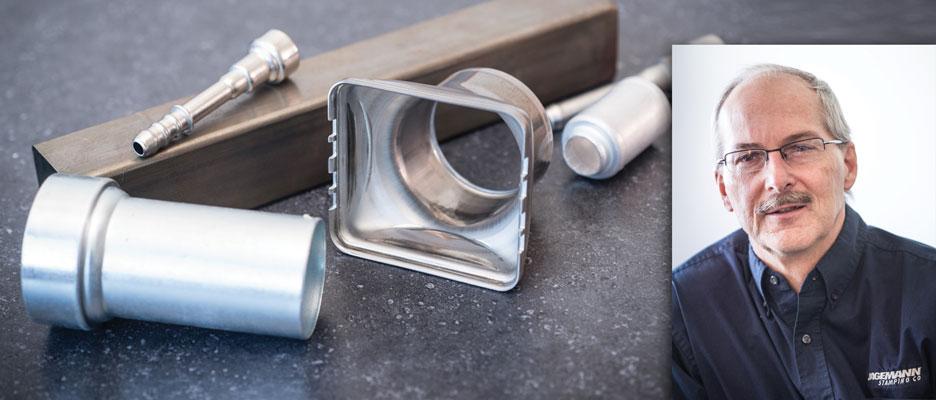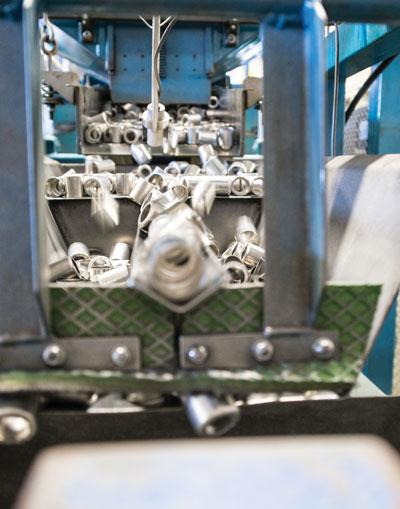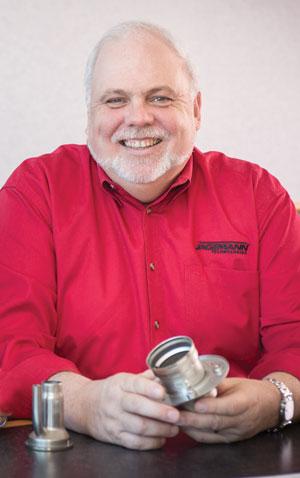Contributing editor
- FMA
- The Fabricator
- FABTECH
- Canadian Metalworking
Categories
- Additive Manufacturing
- Aluminum Welding
- Arc Welding
- Assembly and Joining
- Automation and Robotics
- Bending and Forming
- Consumables
- Cutting and Weld Prep
- Electric Vehicles
- En Español
- Finishing
- Hydroforming
- Laser Cutting
- Laser Welding
- Machining
- Manufacturing Software
- Materials Handling
- Metals/Materials
- Oxyfuel Cutting
- Plasma Cutting
- Power Tools
- Punching and Other Holemaking
- Roll Forming
- Safety
- Sawing
- Shearing
- Shop Management
- Testing and Measuring
- Tube and Pipe Fabrication
- Tube and Pipe Production
- Waterjet Cutting
Industry Directory
Webcasts
Podcasts
FAB 40
Advertise
Subscribe
Account Login
Search
Stamper draws deeply on diversification, technology, community to grow
Develops capacity as deep as its draws
- By Kate Bachman
- March 5, 2014
- Article
- Bending and Forming

Jagemann Stamping’s deep-drawn components are used in batteries, artillery, automotive fuel lines, air filtration and conditioning, solenoids, and many other applications. Shown left to right are a pump housing, square battery can, fuel line quick connect, stainless steel exhaust gas circulation cap for emissions reduction, and an air conditioner ferrule.
In a scene from the 1986 movie “Crocodile Dundee,” Paul Hogan’s character confronts a would-be knife-wielding robber: “That’s not a knife,” he said, pulling out his croc-cutting bowie one. “That’s a knife.”
Jagemann Stamping Co. could make a similar claim with its deep-drawn parts (see lead image).
“A lot of manufacturers consider their draws to be ‘deep,’ but we get into some really deep-drawn parts,” said Jagemann Stamping CEO Tom Jagemann.
“People who aren’t familiar with deep-draw stamping are amazed when we show them products we’ve deep drawn. They don’t realize that every stamped part starts out flat and is drawn from a coil into a shape [see Figure 1]. They think we buy some of our parts as tubes [see Figure 2].”
Developing Deep, Broad Capacity
Jagemann Stamping’s capacity is as deep as some of its draws. The multicapable manufacturer of deep-drawn, progressive, and fineblanked stamped components made from copper, brass, stainless steel, aluminum, and carbon steel draws on its expansive capacity to grow and prosper.
“If you look at the three main types of stampings—you’ve got progressive dies, deep draw, and fineblanking—that probably covers about 80 or 90 percent of anything that’s stamped. And we now offer all three,” Jagemann said. The company has more than 70 presses ranging from 15 to 330 tons.
As if that weren’t diversified enough, the company also performs machining and, at its Murfreesboro, Tenn., plant, plastic insert molding and overmolding.
Having a breadth of offerings puts the manufacturer in the enviable position of being able to offer the best and most cost-effective methods to manufacture parts. For example, company engineers redesigned a machined component as a deep-drawn stamping, improving quality and reducing costs for the customer in the process (see Figure 3).
Being diversified also empowers the company to transfer capabilities from one industry segment to another. Like for most stampers, the automotive industry generated a large percentage of Jagemann’s business activity. When the automotive industry took its nosedive in late 2008-early 2009 and went to Washington to ask for loans, Tom Jagemann went to nonautomotive industry tradeshows to ask, “Can we manufacture stampings for you?”
One industry in particular, the artillery segment, turned out to be a double-barrel opportunity. Not only was demand growing for brass ammunition casings, which are deep-drawn stampings, but the Tier 2-level buyers were eager to find a supplier that was not also a competitor.
“The big boys—the Remingtons, the Winchesters—were the main suppliers … but the Tier 2 loaders don’t want to buy from them because they compete with them. So we just got in at the right place and the right time in that industry. Not only was the industry growing like crazy, the buyers didn’t want to do business with the people they were doing business with.
“So it turned out great. We got into different technologies in stamping and fineblanking.”
As the automotive industry regained traction and the popularity of fuel-efficient vehicles expanded, the company exhausted dual opportunities there too, supplying deep-drawn components for hybrid vehicles.
“The CAFE push supports our automotive business as well,” Jagemann said. “Not only are car sales going up, but because of the technology they’re using to get the CAFE standards, we get to supply more solenoids, VVT and turbo charger components [see Figure 4]. That means more sales. So it’s a win-win.”
Although some of the methods of improving fuel economy and reducing emissions focus on lightweighting, some of it is based on better technology, Jagemann maintains. “All of the engines are going to direct injection, variable valve timing, and 8-, 9-speed transmissions. All of that drives more content for us. More solenoids, more fuel systems components … So even with the same volume of vehicle sales, we double the content. And the same thing with variable valve timing.
“Everything just lined up the last couple of years,” Jagemann added.
Preparing for Growth
As a result, the manufacturer is projected to take in $80 million in sales in 2014. Jagemann added, “Last year we grew by 30 percent over 2012, and we’re looking at 50 percent growth in 2014 over 2013.”
All of the growth in demand prompted Jagemann Stamping to expand its plant to accommodate explosive growth, adding 50,000 square feet to its plant and 130 jobs. It now has a total of 225,000 sq. ft. and 360 employees.
Jagemann Stamping President Ralph Hardt said, “This expansion allows for additional capabilities and capacities to support growth, both now and in the future.” (See Figure 5.)
Tom Jagemann was pleased to draw employees from the talent pool of the Manitowoc community (see Manitowoc sidebar). “I’ve been fortunate to hire really good people [see Figure 6].

Figure 2
This 9.5-in.-tall battery can was
deep-drawn in an 11.8-in.-
stroke servo press, defying
the 40 percent stroke-to-draw
rule. Can you guess how it was
done?
“A lot of our tooling today is made to tenths of thousandths, which requires very skilled toolmakers, specialized equipment, and different training for the operators [see Figure 7]. One of my guiding rules is to always try to hire people smarter than myself. It turned out well.”
Expanding From Deep-Draw Origins
This wasn’t the first time the company accessed its deep well of capacity to find crossover opportunities.
Jagemann Stamping’s technical origin was in deep drawing. “That’s how it started. My grandfather’s first project as the owner of this company was a deep-drawn filter component,” Jagemann explained.
Tom’s father sought and found opportunities in uncharted waters by being one of the first to supply a new and growth-assured segment. In the early ’70s, when cars began to be equipped with air conditioning, he connected with the right customers in that industry to supply ferrules, inserts, and muffler parts for AC systems. “We deep draw a lot of aluminum. All of the air-conditioning hoses are aluminum ferrules. We’ve done them forever.”
Once firmly positioned in the automotive industry, Jagemann also began supplying deep-drawn components for fuel line quick connects, filler, and fuel pumps for automotive customers.
In the early 1980s, the stamper straddled both the automotive and energy storage segments, deep drawing battery cans for rechargeable
batteries. “Our first [battery] customer was Gates Energy. Then they were bought out by Energizer. So we did all of the rechargeable battery cans for Energizer in the ’80s,” Jagemann said.
The company tapered its involvement in that segment and refocused on automotive for a decade or so, forming injector cups, end caps, inlet tubes, and brackets for fuel injector systems.
“And then the slowdown came. So we looked for other places for business,” Jagemann said (see Keeping Watch Over Third-Gen Family Biz sidebar).
Using TLC on Materials
Jagemann said that drawing some of the noncarbon steel materials, such as stainless steel, copper, brass, and aluminum, comes with “issues.” (See Figure 8.)

Figure 3
The stamper re-engineered a machined
brake piston part as a deep-drawn
stamping, resulting in improved quality
and reduced costs for a customer.
“You draw stainless down and the material has to flow. It always stretches a little, but if it stretches too much it’ll tear or wrinkle, and you won’t get the surface finish you want.”
Unlike stainless steel, aluminum is very formable. “But sometimes that’s harder because it tends to tear more easily,” Jagemann said. “Every material has its own unique properties that we have to deal with.”
Drawing brass casings is a compatible operation to drawing battery cans, Jagemann said. Both are deep-drawn parts of similar sizes, so he used the same presses and material handling equipment. “We just reconfigured the equipment for brass,” he said. Although certain aspects of the operation differ, such as tooling, the motion of the machines is the same, and the company had a deep background deep drawing brass.
“With brass and cartridges, you do a lot of ironing. And we’ve got a lot of experience with that.
“So we use all the techniques that our engineers have developed over the years, pushing the material; configuring the perfect die radius; using the correct coatings, coolants, lubricants … We use a lot of different combinations of factors to be successful. That needs to be just right,” Jagemann said.
The company performs some of its deep drawing on servo-mechanical presses (see Figure 9). “You can slow them down during the draw process and then run much higher strokes per minute with the same draw speed as a mechanical press,” he continued. The company installed one of the first servo presses in the country 12 years ago, and just installed two more.
Technology Drives Future
Jagemann said that he believes that the quality and longevity of products made today—especially vehicles—are much improved, and that difference is the direct result of those tighter tolerances and better manufacturing.
The company head also had a lot of praise for the way automakers have approached meeting CAFE standards. “I give automakers a lot of credit. The last time there was a huge fuel crisis and they really had to raise the fuel economy, they got rid of the V8s, everything went to all 4 cylinders, diesels that weren’t so good, and everyone thought that was the end of performance as we knew it.
“Well, this time around it’s the exact opposite. They’re coming out with fuel economy hybrids, and every time you turn around, every motor has better fuel economy and more horsepower and more torque.
“The technology is just phenomenal,” he added.

Figure 4
Very small parts with holes that must
be pressed out of thick material, such
as washers for solenoids and electrical
contacts (pictured), are good candidates
for fineblanking because the process
leaves cleaner edge conditions.
“Thirty years ago if you had a 7-year-old car with 100,000 miles, it was rusted through and the motor was shot. Today cars at 100,000 miles, that’s their first tuneup. And that’s the result of efforts of manufacturers like us who are making things better and better with tighter tolerances and different materials.”
Jagemann draws parallels between that direction and the stamping industry’s direction. “I see the future of stamping going the same way—using technology to get better and better.
Jagemann predicts that servo presses will be the dominant press technology in the future and will be part of how technology will improve stamping.
“There will be a day when there won’t be any mechanical presses, just like there will be a day when cars will all be hybrids or electrics. It’s just going to take time.”
Keeping Watch Over Third-Gen Family Biz
According to the Family Business Institute, only about 30 percent of family businesses survive into the second generation and 12 percent are still viable into the third generation. An article in the January/February 2012 issue of Harvard Business Review calls this situation “Shirtsleeves to shirtsleeves in three generations.”
Jagemann Stamping Co. CEO Tom Jagemann presides over the third-generation family company with cognizance of his family’s efforts to grow the business and a determination that the statistical tendency for third-generation family businesses to fail not befall his company.
“Not on my watch,” he said in his Jesse Ventura voice. “I’m not going to let that happen.”
Jagemann has taken measures to broaden the company’s capabilities to ensure his family business’s continuum and its prosperity.
Jagemann Stamping Co. is very much anchored to the Great Lakes coastal community of Manitowoc, Wis., in which it was founded in 1946. The port town is the launch site of the Lake Michigan ferry SS Badger and showcases the USS Cobia World War II submarine, relics of famous shipwrecks, and 20 miles of Lake Michigan shoreline.
Manitowoc is also home to historically and technologically significant industry, including Parker Hannifin, the former Mirro cookware manufacturer (now Tramontina), Orion Energy, and, of course, ice machine and construction equipment manufacturer Manitowoc Co.
Photos courtesy of Manitowoc Visitors Center.
About the Author

Kate Bachman
815-381-1302
Kate Bachman is a contributing editor for The FABRICATOR editor. Bachman has more than 20 years of experience as a writer and editor in the manufacturing and other industries.
subscribe now

The Fabricator is North America's leading magazine for the metal forming and fabricating industry. The magazine delivers the news, technical articles, and case histories that enable fabricators to do their jobs more efficiently. The Fabricator has served the industry since 1970.
start your free subscription- Stay connected from anywhere

Easily access valuable industry resources now with full access to the digital edition of The Fabricator.

Easily access valuable industry resources now with full access to the digital edition of The Welder.

Easily access valuable industry resources now with full access to the digital edition of The Tube and Pipe Journal.
- Podcasting
- Podcast:
- The Fabricator Podcast
- Published:
- 04/30/2024
- Running Time:
- 53:00
Seth Feldman of Iowa-based Wertzbaugher Services joins The Fabricator Podcast to offer his take as a Gen Zer...
- Industry Events
Pipe and Tube Conference
- May 21 - 22, 2024
- Omaha, NE
World-Class Roll Forming Workshop
- June 5 - 6, 2024
- Louisville, KY
Advanced Laser Application Workshop
- June 25 - 27, 2024
- Novi, MI
Precision Press Brake Certificate Course
- July 31 - August 1, 2024
- Elgin,

































